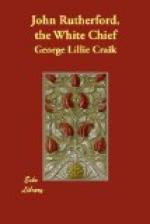The New Zealanders make only two meals in the day, one in the morning and another at sunset; but their voracity when they do eat is often very great. Nicholas remarks that the chiefs and their followers, with whom he made the voyage from Port Jackson, used, while in the ship, to seize upon every thing they could lay their hands upon in the shape of food. In consequence of this habit of consuming an extraordinary quantity of food, a New Zealander, with all his powers of endurance in other respects, suffers dreadfully when he has not the usual means of satisfying his hunger.
The huts of the common people are described as very wretched, and little better than sheds; but Nicholas mentions that those which he saw in the northern part of the country had uniformly well-cultivated gardens attached to them, which were stocked with turnips, and sweet and common potatoes. Crozet tells us that the only articles of furniture the French ever found in these huts, were fishing-hooks, nets, and lines, calabashes containing water, a few tools made of stone, and several cloaks and other garments suspended from the walls.
Amongst the tools, one resembling our adze is in the most common use; and it is remarkable that the handles of these implements are often composed of human bones. In the museum of the Church Missionary Society there are adzes, the handle of one of which is formed of the bone of a human arm, and another of that of a leg.
The common people generally sleep in the open air, in a sitting posture, and covered by their mats, all but the head; which has been described as giving them the appearance of so many hay-cocks or beehives.
The house of the chief is generally, as Rutherford found it to be in the present case, the largest in the village; but every village has, in addition to the dwelling-houses of which it consists, a public storehouse, or repository of the common stock of sweet potatoes, which is a still larger structure than the habitation of the chief. One which Cruise describes was erected upon several posts driven into the ground, which were floored over with deals at the height of about four feet, as a foundation. Both the sides and the roof were compactly formed of stakes intertwisted with grass; and a sliding doorway, scarcely large enough to admit a man, formed the entrance. The roof projected over this, and was ornamented with pieces of plank painted red, and having a variety of grotesque figures carved on them. The whole building was about twenty feet long, eight feet wide, and five feet high.
The residences of the chiefs are built upon the ground, and have generally the floor, and a small space in front, neatly paved; but they are so low that a man can stand upright in very few of them. The huts, as well as the storehouses, are adorned with carving over the door.




